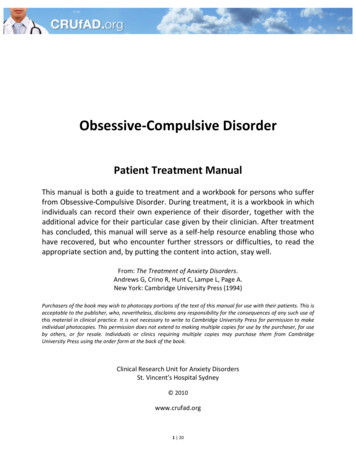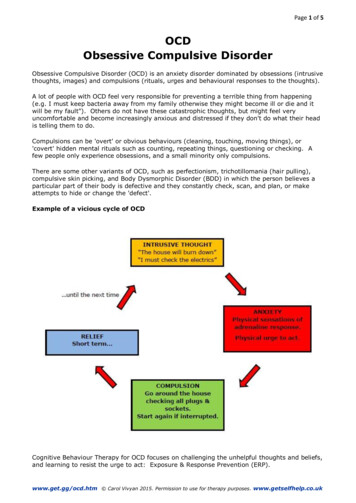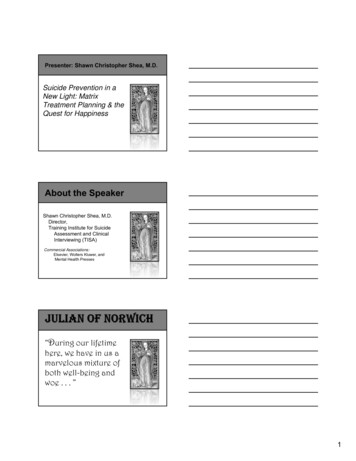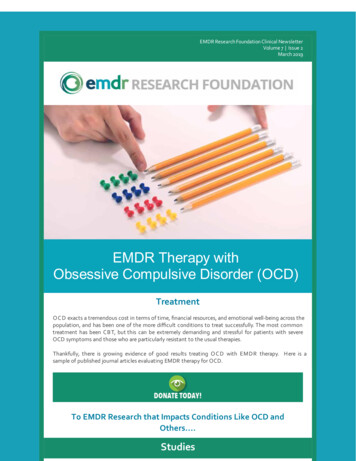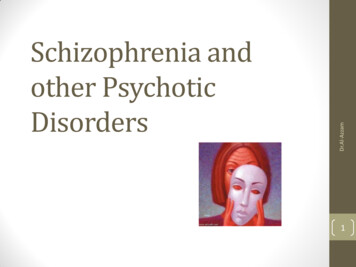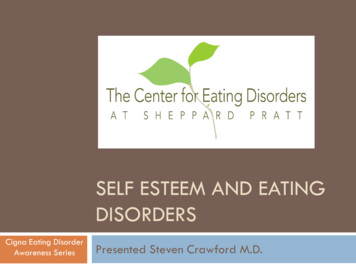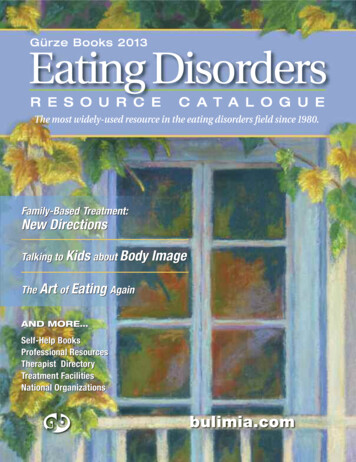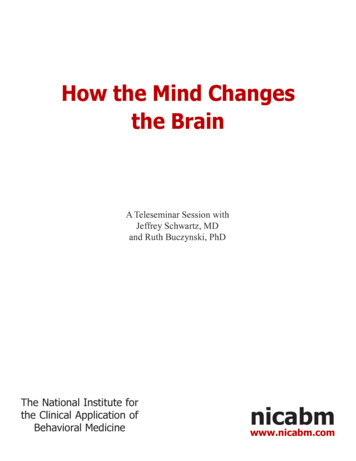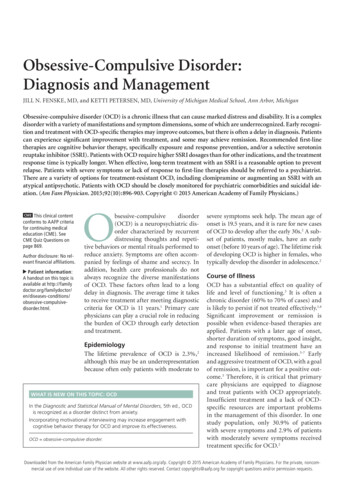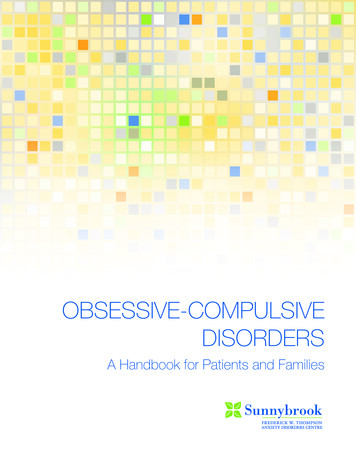
Transcription
OBSESSIVE-COMPULSIVEDISORDERSA Handbook for Patients and Families
Who Is This Handbook Intended for?This information guide is for people with Obsessive-Compulsive Disorder (OCD) and Related Disorders,their family members, friends, and anyone else who may find it useful. It is not meant to include everythingbut tries to answer some common questions people often have about OCD. The information in this guidecan also be used to help people and their loved ones discuss OCD with treatment providers in order to makeinformed choices. We hope that readers will find the information useful.Authors:Eliza Burroughs, M.C., R.P.Vicky Sandhu, MD, FRCPCKate Kitchen, MSW, RSWPeggy MA Richter, MD, FRCPCAcknowledgements:We would like to thank Amanda Calzolaio, Lisa Walter and Maria Vlasova for their invaluable contributionto this Handbook.We would like to thank the Mysak family for the generous funding of this booklet.
Table of ContentsWho Is This Handbook Intended for?2What is OCD?3Common Obsessions4Common Compulsions5What are Obsessive-Compulsive Related Disorders?6Body Dysmorphic Disorder (BDD)6Trichotillomania (also known as Hair-Pulling Disorder)7Excoriation (Skin-Picking) Disorder8Hoarding Disorder9How Do We Know it’s OCD? Assessment & DiagnosisDifferentiating OCD from Other DisordersHow Do People Get OCD?101112Changes in Brain Chemistry12Changes in Brain Activity13Genetic Factors in OCD14Other Possible Causes14Psychological Factors15What Treatments Are Used for OCD?17Psychological Treatment: CBT17Cognitive Strategies19Medication21Role of Medications in OCD Related disorders26How Does OCD Effect Family & Friends?27The Challenge of Dealing with Accommodating, Rituals and Reassurance Seeking29Importance of Taking Care of Yourself30Talking With Children31Managing Recovery & Preventing Relapse32Some Suggestions for Managing the Challenges of Recovery:34Self-Care for Now and the Rest of Your Life35AppendixResource ListObessive Compulsive Disorder38Trichotillomania & Skin Picking40Body Dysmorphic Disorder41Hoarding42Resources for Other Anxiety Disorders43Resources for Mindfulness and Acceptance and Commitment Therapy (ACT)441
2
What is OCD?Bob worried about being responsible for bad things that could happen. He worried about leaving thestove on, which could cause a fire, or hitting someone with his car.He spent all day repeatedly checking every action to make sure he hadn‘t done something wrong ordangerous. For example, Bob would circle back in his car to check if had hit someone and recheckedhis locks over and over again at home to make sure the doors were locked. Bob also avoided using hisoven for fear he might leave it on.The key features of Obsessive-Compulsive Disorderarrange items on a desk), people with OCD feel theyare obsessions and compulsions. Most people have“must“ perform their compulsions and find it almostboth, but for some it may seem as though they haveimpossible to stop. Usually, people with OCD knowonly one or the other.the compulsion is senseless. However, he or she feelsObsessions: Intrusive, repetitive, distressingthoughts, images, or impulses.helpless to stop doing it and may need to repeat thecompulsion over and over again. Sometimes this isdescribed as a ritual. Common compulsions includeexcessive washing and checking, and mental ritualsObsessions are thoughts, images, or urges. They cansuch as counting, repeating certain words, or praying.feel intrusive, repetitive, and distressing.While compulsions often help relieve distress inEveryone has bothersome thoughts or worriesthe short-term, they don’t help in the long- term.sometimes (e.g. worry about money or whether ornot we remembered to lock the front door, or regretover past mistakes). When a person is preoccupiedwith these thoughts, and is unable to control thethoughts, get rid of them, or ignore them, they maybe obsessions. Obsessions are usually unrealistic anddon’t make sense. Obsessions often don’t fit one’spersonality; they can feel unacceptable or disgustingto the person who has them. Obsessions causedistress, usually in the form of anxiety. People withAs a person with OCD gets used to doing them,the rituals become less helpful at reducing his orher anxiety. To make them more effective again,the person may perform them more frequently andfor longer periods of time. This is why people withOCD can appear to be “stuck” doing the same thingover and over again.Compulsions: things a person does to easethe distress from obsessions.obsessive thoughts will often try to reduce thisdistress by acting out certain behaviours, known asFor someone with severe OCD, theserituals or compulsions.compulsions can take up a considerable amountCompulsions are behaviours a person does to relieveof time. Even simple tasks can become verythe distress they feel because of the obsessions. Theycan be overt (observable) or covert (hidden). Whilemost people have preferred ways of doing certainthings (e.g. a morning routine or a certain way totime-consuming, having a significant impacton a person’s ability to manage their daily lives.These difficulties can result in significant shame,sadness, and frustration.3
Obsessive-Compulsive disorder is common:OCD to be one of the top 10 leading causes ofabout 2.5% of the population or 1 adult in 40 aredisability out of all medical conditions worldwide.afflicted, which makes it about twice as commonOther facts about OCD:as schizophrenia and bipolar disorder. It is also the it affects people from all culturesfourth most common psychiatric disorder. It can be rates of OCD are equal in men and women it can start at any age but typical age of onset isadolescence or early adulthood (childhood onsetis not rare however) tends to be lifelong if left untreatedsevere and debilitating: OCD can invade all aspectsof a person’s life; family, work, and leisure can allbe negatively impacted by the disorder. In fact,the World Health Organization (WHO) considersCommon ObsessionsThe list below provides examples of commonReligiousobsessions but doesn’t cover the wide range of Fear of having thoughts that go against one’sreligion Preoccupation with religious images andthoughtsthoughts that OCD can include. Obsessions canbe about anything. if you can think it, OCD canobsess about it.ContaminationAggressive Fear of contamination by germs, dirt, or otherdiseases (e.g. by touching an elevator button,shaking someone’s hand) Fear of harming others (e.g. harming a baby,stabbing someone with a kitchen knife, hurtingsomeone’s feelings) Fear of saliva, feces, semen, or vaginal fluids Fear of harming self (e.g. jumping off a bridge,handling sharp objects) Fear of blurting out obscenities in public (e.g.saying something sacriligious in church)Doubting Fear of not doing something right which couldcause harm to one’s self or another (e.g. turningoff the stove, locking the door)Sexual Fear of having done something that couldresult in harm (e.g. hitting someone with a car,bumping someone on the subway) Unwanted or forbidden sexual thoughts, images,or urges (e.g. urge to touch a parent in a sexuallyinappropriate way) Fear of making a mistake (e.g. in an email, orwhen paying a bill Sexual thoughts involving children or incestOrdering 4Fear of negative consequences if things are not“just right”, in the correct order or “exact” (e.g.shoes must be placed by the bed symmetricallyand face north)
Common CompulsionsCleaning/Washing Washing hands too frequently or in a ritualizedway Ritualized or excessive showering; bathing;grooming routines; cleaning of household itemsor other objects Although not a specific ritual, avoidanceof objects or situations that are considered“contaminated” may be a major problem (e.g.will not shake hands with others or touchelevator buttons)Checking Checking that nothing terrible did, or will,happen (e.g. checking driving routes to makesure you didn’t hit anyone with your car) Checking that you don’t make mistakes (e.g.rereading everything you have written, or askingoothers whether you said the “wrong” thingOrdering/Arranging the kitchen must be perfectly lined up; can onlywear certain coloured clothes on certain days)Mental Rituals Needing to count to certain numbers, thinkcertain ‘good’ or neutral thoughts in response to‘bad’ thoughts, or pray repeatedlyHoarding** Collecting “useless” items such as newspapers,magazines, bottles, or pieces of garbage Difficulty parting with unnecessary or excessivebelongings (e.g. items that may have been usefulonce, or have sentimental value even thoughthey are not needed, or are simply excessive,such as 30 black sweaters) Inability to throw these items away**Although hoarding used to be considered a featureof OCD, it is now thought of as a separate butrelated condition; See BelowEnsuring that things are “just right” orconsistent with a specific rule (e.g. everything in5
What are Obsessive-Compulsive Related Disorders?There are several disorders that seem to be related to Excoriation (Skin- Picking) DisorderOCD. They share similar features such as intrusive Hoarding Disorderthoughts and/or repetitive behaviours. AlthoughThese issues each seem to occur in about 1-4% ofsimilar, there are important differences to considerwhen looking at effective treatments.the general population, although there is speculationthat hoarding may be far more common. SeverityObsessive-Compulsive Related disorders include:ranges but when they impair a person’s functioning Body Dysmorphic Disorderor when they cause significant distress, treatment Trichotillomania (Hair-Pulling Disorder)may be necessary.Body Dysmorphic Disorder (BDD)No matter how much her mother tried to convince her that it was not true, Keisha really believedthat she was ugly. At first she thought her skin was flawed, and then that her nose was too large. Later,whenever she looked in the mirror, she was convinced that she was so disturbing for others to look atthat she avoided going out in public.People with BDD are overly concerned about andistress as a result. For many, the concern can causeimagined or minor flaw in their appearance. Theserious impairment in their day-to-day lives. BDDfocus of concern is often the face and head, butis considered by mental health professionals to be inother body parts can become a focus. While mostthe same category of conditions as as OCD, due topeople would probably like to change one or twotheir similarity. For example, BDD involves intrusiveaspects of their appearance, people with BDD areand recurrent thoughts about one’s appearance asvery preoccupied with these issues. They feel intensewell as compulsive behaviours to ease the distress ofthese thoughts. A person may be very concerned byBody Dysmorphic Disorder (BDD):preoccupation with an imagined or slightflaw in one’s appearance. BDD oftenincludes repetitive behaviours that are donein response to appearance concerns.the shape or size of their nose and repetitively checkmirrors, ask for reassurance, or consult with cosmeticsurgeons in attempts to relieve their distress. Like thecompulsions in OCD, these behaviours may provideshort-term relief (e.g. “my nose doesn’t look too badin that mirror”) but make things worse in the longrun (e.g. increase need to check mirrors).6
Trichotillomania (also known as Hair-Pulling Disorder)Jasmine first started pulling her hair in her teens,and over time she noticed that the hair had notgrown back. She was very embarrassed by herbald spot, and started wearing hats all the timeto cover it up. Jasmine also started avoidingsocial situations because of her appearance butstill could not stop.Trichotillomania involves recurrent hair pulling,resulting in noticeable hair loss. People withcompulsive hair pulling may pull hair from anypart of their body, including the scalp, eyebrows,eyelashes, pubic area, and legs. Severity rangesbroadly: for some, thinning areas are visible onlyupon close inspection, while others pull to thepoint of baldness. For some, the urge to pull canbe managed with simple tools like relaxation andincreased awareness. For others, the urge can beso strong at times that it feels impossible to resist.tension which are relieved after pulling. For others,Many people wear wigs, hats, or scarves to disguisepulling seems to happen automatically with littlethe hair loss on their scalp, while others may useawareness and no sense of tension or relief.make-up or false eyelashes for hair loss in otherareas. The repetitive nature of pulling seems similarto compulsions in OCD. However, the pulling isusually done for different reasons. For some, theTrichotillomania (Hair-pulling Disorder):compulsive hair pulling to the point ofnoticeable hair loss.need to pull happens in response to feelings of7
Excoriation (Skin-Picking) Disorder(also known as Dermatillomania; pathological skin picking, neurotic/ psychogenic excoriation)Ahmed began picking at a spot on his arm where he felt there might be a small bump. Overtime he found himself picking at any irregularity or bump on his skin, resulting in scarring anddiscolouration. This impact on his appearance made it hard for Ahmed to wear short sleeves, or feelcomfortable in social settings in warmer weather.Hair-pulling and skin-picking disorders fall under anExcoriation (Skin-Picking) Disorder:compulsive skin-picking resulting innoticeable damage to the skin.umbrella of similar behaviours called Body-FocusedRepetitive Behaviours (BFRBs). Other BFRBsinclude compulsive nose-picking, cheek-biting, andnail-biting.Similar to hair pulling, skin picking is thought to becompulsive when it becomes recurrent and results innoticeable scarring and/or damage to the skin.People with compulsive skin picking will makerepeated efforts to stop or reduce their picking, andare significantly distressed by their behaviour. Skinpicking can occur on any part of the body, includingthe face, scalp, lips, and legs. While it is often donein response to a perceived imperfection, this is notalways the case. Regardless, compulsive pickingresults in pain and damage to the skin.8Body-focused Repetitive Behaviours(BFRB): repetitive behaviours that causedamage to one’s appearance and/or physicalinjury
Hoarding DisorderRaoul found it hard to throw things away, especially papers. He worried that he might throw awaysomething that he would need at a later time. He had collected so much paper that there was noroom for anyone else in his apartment. He knew that it was a fire hazard and could no longer use hisbedroom, but still could not bring himself to throw things away.People with hoarding disorder have trouble withand exits, infestation with rodents and insects, lungstuff. They acquire too much stuff and/or havedisease, and inability to maintain good hygeine.trouble getting rid of it. The types of things thatHoarding shares some similar features with OCD:people hoard can vary but are often perceived assome people describe obsessional thinking aboutpotentially useful in the future, valuable or as havingtheir belongings and a compulsive need to acquiresentimental value. Like all the disorders describeditems. Also, the distress felt when having to resisthere, saving and collecting occurs on a continuum.acquiring or when discarding items is consideredMost people save some items that they considersimilar to the anxiety in OCD. However, theuseful or sentimental but when a space becomesthoughts are not typically described as intrusive orcluttered enough to compromise intended usedistressing and the behaviour is not ritualistic and is(e.g. unable to sit on couch in living room due tooften considered pleasurable.clutter) or the person is unable to maintain a safeenvironment for themselves and others, a diagnosisand treatment may be warranted. Potential risksof hoarding include fires, falls, blocked entrancesHoarding Disorder (HD): persistentdifficulty getting rid of possessions becauseof a perceived need to save them.9
How Do We Know it’s OCD? Assessment & DiagnosisEveryone will have upsetting thoughts and manysevere anxiety. Sometimes individuals dealing withpeople have certain ways of doing things. For most,depression will become intensely preoccupied withthese thoughts and behaviours are not a problem.thoughts regarding their past failures. AccurateWhat makes someone with OCD different?assessment is important because it helps guidesAssessment and diagnosis of OCD involves makingtreatment. Different challenges require differentthe distinction between normal thoughts andsolutions. It is also important to note that OCDbehaviours and a diagnosable condition. The bigcan also occur at the same time as other disorders.distinctions are the amount of time occupied bySometimes a clinician may determine that oneobsessions and compulsions, the degree of distress,problem is “primary” which may mean it needs to beand/or the level of impairment (e.g. difficultytreated first before other disorders can be addressed.attending work or school, or inability to socialize).As mentioned, OCD is similar to other disordersThe American Psychiatric Association (APA) definesin some ways. Below is a list of disorders that areOCD in the following way:commonly confused with, or can occur at the sameThe presence of obsessions and/or compulsionstime as OCD. It may be useful to talk to yourwhich occupy more than one hour per day, causehealthcare provider about the differences in moremarked distress OR significantly interfere withdetail to make sure you find the right help.functioning.Common Anxiety Disorders Obsessions ·· persistent unwanted thoughts, images, orimpulsesPanic disorder (fear of recurrent, unexpectedpanic attacks) Agoraphobia (fear of specific situations suchas buses or trains, crowded places or of leavinghome alone) Generalized Anxiety Disorder (excessive worryabout real-life concerns, e.g. health or money) Social Phobia (fear of scrutiny, humiliation orembarrassment in social situations) Specific Phobia (fear of a particular object orsituation, such as heights or snakes) Post-traumatic Stress Disorder (the re-experienceof fear following a traumatic event) Anxiety disorder due to a general medicalcondition (anxiety symptoms are directly relatedto a medical condition; can be ruled out byphysician’s exam) Substance-induced anxiety disorder (anxietydirectly related to the effects of a substance, suchas cocaine)·· Intrusive, uncontrollable/excessive·· provoke anxiety Compulsions·· repetitive behaviours or mental acts·· performed in response to an obsession, or inritualistic fashion·· intended to reduce discomfort or preventfeared eventMental health professionals use specific interviewstrategies and questionnaires to determine whetheror not a person has OCD. Clinicians are carefulto ensure that a person’s symptoms are not betteraccounted for by a different problem, cliniciansare careful to “rule out” other possibilities. Forexample, many anxiety disorders have similarities:fear of specific situations or things; avoidance;10
Differentiating OCD from Other DisordersObsessive-Compulsive PersonalityDisorder (OCPD)DepressionObsessive Compulsive Personality Disorder andin OCD: a depressed person is likely to ruminateOCD are two different conditions with similarabout past mistakes and perceived failures whereas anames. A diagnosis of OCPD describes personalityperson with OCD typically fears things that couldtraits such as extreme perfectionism, indecision,happen in the future. Another important differenceor rigidity with details or rules. People withis that people with depression often brood over theirOCPD are often highly devoted to work and canemotional state as a way to understand it better,become “workaholics”. Other features of OCPDwhereas people with OCD usually try to avoid orinclude being excessively meticulous and difficultyneutralize recurrent thoughts.Thoughts in depression are different than thoseexperiencing affection or enjoyment with others.While many people with OCD report having one ortwo of these traits, a person who has five or more ofthese traits will warrant a diagnosis of OCPD. Thereare important differences between the two diagnoses,particularly in terms of treatment.11
How Do People Get OCD?Like most psychiatric conditions, research indicatesa combination of biological, psychological, andthat there is no single cause of OCD. Instead,sociocultural factors.most experts agree that OCD is likely caused byChanges in Brain ChemistryNeurons: cells in the brainother related disorders. Serotonin, for example, is aneurotransmitter that is important in the regulationNeurotransmitter: a chemical in the brainthat helps transmit signals from one neuronto anotherof mood and impulse control. It also affects memorySerotonin, dopamine, glutamate: naturallyoccuring neurotransmitters in the braincertain brain areas and the development of OCD,and learning processes. There seems to be a linkbetween decreased levels of available serotonin inas well as other conditions such as depression andanxiety disorders. The antidepressant medicationsChemical messengers in the brain, known asused to treat OCD work by raising the level of thisneurotransmitters, transmit signals between brainmessenger in the brain. Dopamine is an importantcells (neurons). These signals are the biologicalneurotransmitter for the reward systems in the brain,basis in the brain for most of our experiences,and has also been linked to OCD, and similarlylike mood, sleep, memory and learning. Someantipsychotic medications which affect dopamineof these neurotransmitters are believed to play acan also sometimes be helpful to OCD. Anotherlarge role in the development of OCD, hoarding,major neurotransmitter, glutamate, is now beingtrichotillomania, compulsive skin picking, andinvestigated in its role in the development of OCD.12
Changes in Brain ActivityThe prefrontal cortex is another structure implicatedin OCD. It is involved in regulating appropriatesocial behavior. Diminished activity in this area canlead to poor impulse control, impaired judgmentand lack of remorse. Increased activity may thereforebe related to increased worry about social andmoral concerns, such as meticulousness, cleanlinessand fears of being inappropriate, all of which areamplified in OCD.Researchers and clinicians are able to study the levelsof brain activity, or metabolism, with advancedimaging techniques such as Positron EmissionTomography (PET), Single Photon EmissionComputed Tomography (SPECT) and functionalMagnetic Resonance Imaging (fMRI). Such studieshave consistently shown that individuals with OCDhave increased levels of activity in three areas of thebrain: the basal ganglia, prefrontal cortex, andcingulate gyrus.The caudate nucleus is a deep brain structure locatedin the basal ganglia. It is believed to act as a filter,Positron Emission Tomography (PET):A brain imaging technique that producesa three-dimensional images of chemicalchanges in the brainSingle Photon Emission ComputedTomography (SPECT): similar to PETscans, SPECT is a brain imaging techniquethat can give information about blood flowand chemical reactions.functional Magnetic Resonance Imaging(fMRI): measures brain activity by lookingat changes in blood flow in the brain.screening messages that it receives from other areasof the brain. It also regulates habitual and repetitiveThe cingulate gyrus helps regulate emotion. It isbehaviors, such as those observed in OCD andalso involved in predicting and avoiding negativerelated disorders. Interestingly, the increased level ofoutcomes, and recognizing errors. In OCD,brain activity in this area normalizes in individualsincreased activity in this brain regionmay be relatedafter successful treatment of OCD, either withto the emotions triggered by obsessive thoughts andmedications or cognitive behavior therapy. Thistofeelings that one has made a mistake or not donedemonstrates that changes in ‘thinking’ that occur insomething correctly. This area is well connected totherapy can alter physical functions in the brain.the prefrontal cortex and basal ganglia via a numberof brain circuits.13
Genetic Factors in OCDTourette’s Syndrome (TS): a neurologicaldisorder characterized by tics. Tics arerepetitive, involuntary, and suddenmovements and/or vocalizations.There is a lot of interest in the exact genes involvedin OCD. Such potential gene ‘candidates’ mayinclude genes that are involved in the regulation ofserotonin and other brain chemicals. At this pointin time, although changes in specific genes havebeen identified that may contribute to the risk ofIt is widely agreed that OCD and its relatedthe illness, the effect of of these variants is too smalldisorders can run in families. Almost half of all casesto be clinically helpful. However in the near futuredemonstrate this pattern. Studies show a highergene testing may be able to help better predict thelikelihood that close relatives of a person with OCDfuture course of the illness, or response to treatment.(e.g. parents, siblings or children) have or willdevelop the disorder at some point in their lifetimes.Although OCD symptoms can be ‘learned’ fromaffected family members, relatives with OCD oftenhave different obsessions and compulsions.There is also a relationship between OCD andTourette’s syndrome (TS). Family members ofindividuals with TS often show higher rates ofOCD than the general population, also suggesting agenetic relationship between these disorders.Other Possible CausesIn a minority of children, the development of Groupof OCD symptoms, suggesting that variations inA Streptocococcal infection (‘strep throat’) has beenhormone levels may play a role.associated with the onset or worsening of OCDOCD symptoms that develop quickly after asymptoms. In these cases, OCD or TS symptomsdevelop very abruptly after infection. Some scientistsbelieve this may be an autoimmune response, wherethe body mounts an immune response by attackingthe basal ganglia in the brain. There is currently noevidence that this, or other infectious agents, play arole in the development of OCD in adulthood.For some women, premenstrual and postpartumperiods can lead to the development or worsening14traumatic event have been observed in certain cases.This suggests that stress can contribute to the onsetof OCD symptoms.There have been small studies showing that damageto the brain, such as stroke or traumatic brain injury,in certain areas can also give rise to new OCDsymptoms.
Psychological FactorsCognitive Theorymay start to avoid being alone with their child, orCognitive (i.e. thought processes) theory focusesmust think “good thoughts” to counter the “badmainly on the thoughts in OCD, instead of thethoughts”.behaviours. It is based on the idea that thoughtsCognitive theorists have identified several patternsimpact how we feel. In OCD, this theory suggestsof beliefs that are common in OCD. Theythat people with OCD misinterpret their thoughts.may contribute to the ways people with OCDIt is not the obsession itself that is the problem, it ismisinterpret their thoughts.the way the obsession is interpreted. Over-inflated sense of responsibility: the beliefthat you are solely responsible for preventingharm to others. Exaggerated sense of threat: a tendency tooverestimate the likelihood of danger Over-importance of thoughts: thoughts arevery important and must be controlled Thought-action fusion: just having a thoughtincreases the chances that it will come true and/or that I will act on itspecial attention. The importance of the thought gets Perfectionism: mistakes are unacceptableexaggerated, which causes the person to feel anxious. Intolerance of Uncertainty: a need for 100%certainty about a given situationResearch shows that most people without OCDhave thoughts, urges, or images similar to theones reported by people with OCD. Intrusive anddisturbing thoughts (e.g. harming a loved one orleaving the stove on and starting a fire) are normaland common. However, for most people, thesethoughts don’t become a problem because they don’tget any special attention; they are easily shruggedoff. For people with OCD however, the thought getsThis leads them to react to the thought as thoughit were an actual threat. They might think, “SinceI had that thought of hurting my child, I must bea dangerous person”. This interpretation can causeintense anxiety, disgust, and guilt. Once thoughtsbecome interpreted in such a way, people with OCDwill try to reduce or eliminate that distress by doingcompulsions or by avoidingsituations that triggerIn cognitive therapy (discussed more in Treatmentsection), people learn to think in more rational andbalanced ways. Cognitive therapy is not about tryingto think only good thoughts or to assume there areno dangers in the world; it is about using skills thathelp us look at situations based on facts, not fear.the disturbing thoughts. In this example, a person15
Behavioural TheorySocial and Cultural FactorsUnlike cognitive therapy, which looks at thoughs,Research on OCD in different cultural groupsbehaviour therapy focuses on the behaviours insuggests that there are no big differences acrossOCD. According to behaviour theory OCD makescultures, age, or between genders. Instead, OCDconnections between certain situations and fear (e.g.symptoms often seem related to the things we valuepublic bathroom anxiety). In order to reduce thatmost or that are particularly relevant in our lives.fear, the person learns to avoid those situations orFor example, obsessions about harming one’s baby isdo rituals. A link is formed between the compulsioncommon amongst new parents with OCD. Similarly,and feeling better. The more someone avoids orindividuals raised in religious homes may developritualizes in response to this fear, the stronger thatobsessions that seem to contradict one’s religiouslink becomes. The stronger this connection, thebeliefs (e.g. sexual thoughts about Jesus Christ).more likely a person is to continue their avoidanceor rituals because they don’t
4. Obsessive-Compulsive disorder is common: about 2.5% of the population or 1 adult in 40 are afflicted, which makes it abo
